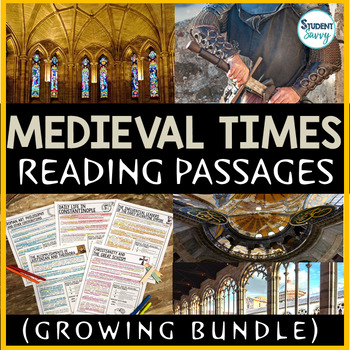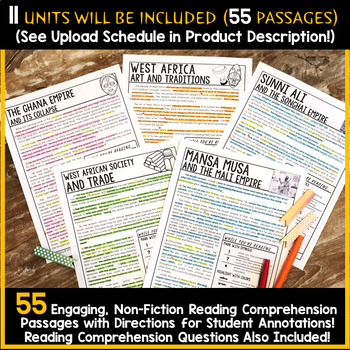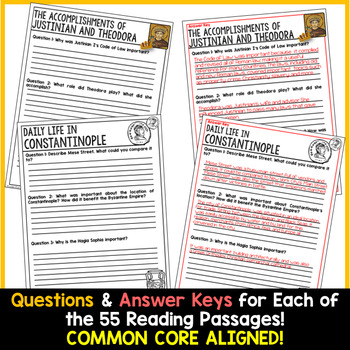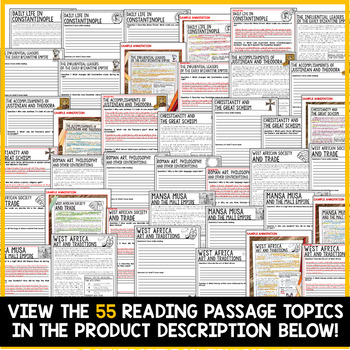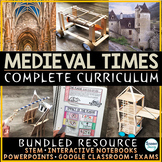Medieval Times Reading Passages Bundle - Middle Ages Reading Comprehension
- Zip
- Easel Activity
What educators are saying
Products in this Bundle (12)
showing 1-5 of 12 products
Also included in
- Enhance your Middle Ages curriculum with our Medieval Times and Early Modern Times Complete Curriculum Bundle, available in digital Google Classroom and PDF print formats. With over 1500 pages/slide of material, this comprehensive resource covers Early Byzantine, Early Islam, West Africa, MedievalPrice $190.00Original Price $314.93Save $124.93
- ALL of the Reading Comprehension Passages in the StudentSavvy Store! Nonfiction **CURRENTLY 273 Passages!**-Worksheets - Reading Comprehension Passages, Questions, and Annotations--Both Print (PDF) & Digital Options (either in Google Slides or Easel by TpT) It contains Engaging, Non-Fiction ReadPrice $195.00Original Price $302.21Save $107.21
Description
Medieval Times Reading Comprehension Passages, Worksheets, Questions, and Annotations Bundle!
This bundle contains 11 StudentSavvy Reading Passage Resources!
1.) Early Byzantine Reading Passages
2.) Islam – Islamic World Reading Passages
3.) West Africa Reading Passages
4.) Medieval China Reading Passages
5.) Medieval Japan Reading Passages
6.) Medieval Europe Feudalism Reading Passages
7.) Medieval Europe Late Middle Ages Reading Passages
8.) The Renaissance Reading Passages
9.) The Reformation Reading Passages
10.) Mesoamerica Reading Passages
11.) The Scientific Revolution Reading Passages
This resource contains a total of 55 Engaging, Non-Fiction Reading Comprehension Passages with Directions for Student Annotations! Reading Comprehension Questions also included!
Questions & Answer Keys for Each of the 55 Reading Passages!
COMMON CORE ALIGNED!
Aligned with Medieval Times Interactive Notebook
Find the Complete Medieval Times Curriculum Here!
Here is a quick overview of topics covered in this resource:
Early Byzantine
1.) Daily Life in Constantinople
-Describes Constantinople as the capitol and center of trade and business
-sat at a crossroads/trade center between the Aegean Sea and Black Sea (access by seas as well as by land)
-Mese – the main street of Constantinople (comparison to New York’s Main Street)
-Hippodrome – large stadium in Constantinople that holds chariot races.
-Hagia Sophia – one of the wonders of the world in the Medieval Ages.
Keywords: Hagia Sophia, Hippodrome, Constantinople, Mese
2.) The Influential Leaders of the Early Byzantine Empire
-Describes the major accomplishments and major events of influential leaders during Early Byzantine Empire (introductory paragraph + a paragraph on each ruler)
-Emperor Diocletian (in power during 284-305AD) -splitting the Roman Empire into Eastern and Western
-Emperor Constantine (in power during 312-337AD) The first roman emperor, built Constantinople
-Emperor Justinian (527-565AD) – the Justinian Code of Law and the Golden Age of Byzantium.
-Empress Theodora (527-548AD) – advocated for rights of women and children, ruled alongside Justinian. She helped assist him to end the riots in Constantinople
Keywords: Byzantine Empire, Emperor
3.) The Accomplishments of Justinian and Theodora
-Describes their upbringing (Justinian born a peasant and son of farmer – Theodora was an actress and they fell in love)
-Describes The Justinian Code – collection of laws, made up of four books of laws.
-Describes how Theodora helped end the riots in Constantinople (Nika Revolt)
-Theodora created laws that would empower and protect women
Keywords: Justinian Code
4.) Christianity and The Great Schism
-Describes how the Eastern and Western Churches split apart after The Great Schism -the Western Roman Catholic Church, the pope claimed authority over everyone, including emperors and kings. In the East, the emperor still rules over the patriarch and is the leader of the church.
-Compares and contrasts the similarities and differences of the West Roman Catholic Church and the Eastern Orthodox Church (mention the use of icons and how Leo III banned them from the church)
Keywords: Roman Catholic, Pope, Icons, Schism, Orthodox
5.) Roman Art, Philosophy, and Other Contributions
-Brief overview of contributions (art, philosophy, aqueducts, roads, etc)
-Describes Mosaic art – how it was popular and used in churches and other important buildings – a sign of wealth and importance.
-Describes Stoicism and philosophy during this time. Important concepts of duty and virtue. The idea of playing an active role in society and how it helped strengthen Rome at the time.
Keywords: mosaic, Stoicism
_________________________________________________________
Islam - Islamic World
1.) Nomads, Townspeople, and The Arabian Peninsula
-describes the location and climate of the Arabian Peninsula and those who traveled on the Arabian Peninsula
-describes nomadic lifestyle versus townspeople
-describes town centers / trade centers along the trade routes
-describes the goods that were traded, the plants and animals, the type of soil, etc.
Keywords: caravans, oasis, souk, bazaar, nomads, townspeople
2.) The Holy City of Mecca
-Describes the Holy City of Mecca and how believers travel to there at least once in their lifetime to perform Hajj (pilgrimage)
-Brief overview of Muhammad and how this is the city he was born in
-Describes how it was a center for trade where nomads and merchants came to trade their goods
Keywords: pilgrimage, Muslim,
3.) The Five Pillars of Islam
-Provides an overview of the Five Pillars of Islam and how they are the foundation of Muslim life.
-Describes each pillar in detail
Keywords: Shahadah, Salah, Zakah, Sawm, Hajj
4.) Islamic Beliefs and Way of Life
-Provides a brief overview of Muhammad and The Qur’an
-Describes what Mosques are and Muhammad’s following
-Gives an overview of prayer in the Muslim community (5 times a day)
-Describes how Sunnah is used as a guide for a way of life.
Keywords: Sunnah, Mecca, Muhammad, The Qur’an, Mosque
5.) Cultural Achievements in Islam
-Brief overview of cultural achievements in medicine, art, astronomy, literature, and architecture.
-Overview of Medical advancements – wrote encyclopedias and kept descriptions of drugs (how it helped treat and prevent diseases)
-Muslim Art – unique how it did not include images but rather calligraphy
-Astronomy – improvements on the astrolabe – charting directions through the stars, helped to know which direction to turn to Mecca
-Literature – describe popular forms, authors, and stories
-Architecture – building of the mosques, domes, arches
Keywords: astrolabe, Calligraphy, astronomy, mosque
__________________________________________________________
West Africa
1.) West African Society and Trade
-Trade and natural resources helped kingdoms rise to power in West Africa.
-The importance of salt and gold and how that allowed Ghana to become a prosperous empire.
-Description of age sets and village society
-Description the resources found (dates, kola nuts, trees, iron, gold etc.)
Keywords: age sets, Savannah, extended families, Sahara
2.) The Ghana Empire and its Collapse
-Description of its location between the two rivers and the first people (the Soninke) to develop a civilization there
-The capital city (Kumbi Saleh) and how it became an oasis for travelers and traders.
-Tunka Manin and other powerful rulers during the Ghana Empire
-description of trade and how it became a prosperous empire
-The decline and collapse of Ghana beginning in the 1200’s. The three possible reasons (over-grazing, invasions, and internal fighting) that attributed to the collapse.
Keywords: Tunka Manin, Ghana Empire, Kumbi Saleh,
3.) Mansa Musa and the Mali Empire
-Location of the Mali Empire (along the upper Niger River)
-Description of how Sundiata helped Mali first rise to power (created an army and overtook kingdoms and territories) He took over gold and salt trades.
-Overview of Mansa Musa and how he spread Islam during his rule - His achievements (capturing major cities)
-The hajj (pilgrimage to Mecca) and how he made Mali famous
Keywords: Mansa Musa, Sundiata, hajj, Mali Empire
4.) Sunni Ali and the Songhai Empire
-Introduction how the empire began as part of Mali’s empire
-Description of Sunni Ali’s achievements (reigned during 1464-1492) (transformed Gao into the empire of Songhai, strengthened and unified empire)
-His son took over the throne after his death in 1492, Askia Muhammad
Keywords: Sunni Ali, Songhai Empire
5.) West Africa Art and Traditions
-Introductory/overview about the different types of traditions, including oral history and Griot storytellers, West African proverbs, masks, sculptures, dance, etc.
-Describes the art and unique designs of kente cloth
-Describes West African proverbs and oral history
-Describes West African art: including masks, sculptures, music, instruments and dance
Keywords: oral history, griots, proverbs, kente cloth, proverbs
________________________________________________________________ Medieval China
1.) Reunifying China During the Sui and Tang Dynasty
-Overview of the two Dynasties and how they reunified China and brought order after the fall of the Han Dynasty and Period of Disunion. Yang Jian (known as Emperor Wendi) helped reunify China
-Describes achievements during Sui Dynasty such as the building of the Grand Canal, political changes, and others.
-Tang Dynasty overview, period of expansion, and Golden Age.
-Describes other cultural achievements in detail, poetry, writing, etc.
-Mentions influential emperors during that time, such as Yang Jian (known as Wendi) during the Sui Dynasty - Taizong, Xuanzong, and Empress Wu (during the Tang Dynasty) and their accomplishments.
Keywords: Period of Disunion, Grand Canal, the Great Wall
2.) Advancements in Medieval China during the Tang and Song Dynasties
-Overview of the fall of the Tang Dynasty and Period of the Five Dynasties and Ten Kingdoms
-Describes the Chang’an capital
-Describes how trade advancements helped China prosper (Land and sea trade) Silk (Tang Dynasty) and Porcelain (Song Dynasty)
-Tang and Song inventions including wood-block printing, movable type, medicinal tea, porcelain goods
Keywords: movable type, Chang’an capital
3.) The Mongol Empire and Kublai Khan
-Provides an overview of what the Mongol Empire was like
-Describes the four sections called “Khanates”.
-Describes how Genghis Khan united the tribes and mention his conquests.
-Describes his grandson Kublai Khan and what he gained control of.
-Explains the different methods of how they maintained control.
Keywords: Mongol Ascendancy, conquest
4.) Zheng He and the Seven Sea Voyages
-describes the seven sea voyages around Asia.
-describes Yongle’s purpose for leading the voyages.
-describes the fleet of treasure ships that Zheng he commanded during his voyages.
-mentions where Zheng He traveled and his experiences
-describes what “tribute” is
Keywords: voyage, tribute, maritime
5.) The Ming Dynasty and China’s Period of Isolationism
-Overview of how Zhu Yuanzhang defeated the Mongol’s rule and established the Ming Dynasty.
-Ming Dynasty was a period of sea voyages and exploration. Describes how it restored China
-Describes The Forbidden City in detail and what type of leader Yongle was
-later in 1430, describes how China entered a period of isolationism. A new emperor forced Zheng He to return from his voyages.
-describes the impact isolationism had on China
Keywords: Imperial, The Forbidden City, isolationism,
________________________________________________________________
Medieval Japan
1.) The Land of the Rising Sun and Japanese Society
-Introduction to Early Japanese Society, structured around powerful families and clans.
-describes the land/islands, farming, and extreme weather
-explains how extreme weather aided the Japanese army when attacked by the Mongols.
-Overview of Japanese society, village workers, nobles, emperors, regents, etc.
-describes how China influenced much of Japan’s religion, government, agriculture, etc.
Keywords: Emperor, Regent, clans, succession, court
2.) Shinto Beliefs and Zen Buddhism
-overviews of Japanese culture and their respect for nature, quiet reflection, spirits, ancestors, and balance.
-overviews of Shinto (the way of the gods) beliefs. Overview of kami (divine spirits)
-describes animism and how it relates to Kami
-Describes Zen Buddhism and how it is an adaptation of traditional Buddhism. Describes how it focuses on quiet reflection, meditation, intuition, and assisted Japanese samurai into battle.
Keywords: kami, Shinto, Zen Buddhism, Zen,
3.) The Tale of Genji and Lady Murasaki Shikibu
-Introduces Lady Murasaki Shikibu – famous writer who lived at the emperor’s court.
-Describes her famous novel, The Tale of Genji
-Overview of plot, setting, etc.
Keywords: court, imperial,
4.) Feudalism and a Military Society
-Introduction to Feudalism (Daimyo having control of the land and weakening the government)
-Describes hierarchy in Medieval Japanese Society
-Describes Minamoto Yoritomo and how he was the first shogun
-Describes three powerful military leaders Oda Nobunaga, Toyotomi Hideyoshi, and Tokugawa Ieyasu
Keywords: shogun, daimyo, vassal,
5.) Samurai and The Way of the Warrior
-Overview of samurai culture in Medieval Japanese society.
-describes bushido, code of honor, and loyalty to their lords
-describes their day-to-day training, jujitsu, wrestling, etc.
-describes how meditation and focus was also important in their practice.
Keywords: bushido, samurai, pledge, Daimyo
______________________________________________________________
Early Middle Ages - Medieval Europe
1.) Feudalism in the Early Middle Ages
-Introduction/Overview of how after the collapse of Rome, there was no large system of government.
-describes a decline in education and the changes after the fall of Rome (reduction in trade, decline in education, etc.) and how it impacted Europe
-eventually led to feudalism, basis of society.
-overview of feudalism (agreement between vassals and lords)
Keywords: feudalism, medieval, fiefs
2.) Charlemagne
-Overview of his history and how he created a European empire
-Describes how he was crowned Holy Roman Emperor
-Overview of all of his major accomplishments
(military campaigns, spreading Christianity, creating schools, etc)
3.) Manor Life
-Introduction of life on the manor. Describes what a manor consists of. Description of how it was it’s own micro-word and self-sustaining.
-describes the things that characterized the middle ages during the manor time period (no real government, very little trade, political chaos, kingdoms)
-overview and description of Early Medieval hierarchy (Kings, nobles, knights, peasants)
Keywords: manor, baron, fiefs, vassal, manor, lord, feudalism, serf, squire
4.) The Benedictine Rule and Christianity
-Overview of Christianity in Early Medieval Europe and how it spread.
-Describes missionaries, monks, Saint Patrick, monasteries, and the Benedictine Monks.
-Ways monks aided the communities (helped others read and write, healthcare, etc.)
-Describes who Saint Benedict of Nursia was and what the Benedictine Rule and Benedictine Order is and what the rules were that Benedictine monks must follow.
Keywords: monastery, The Benedictine Rule, bishop, monk,
5.) A Comparison of Feudal Europe and Feudal Japan
-Introduction to Feudal Europe and Feudal Japan
-Compares and contrasts the similarities and differences in Early Medieval Europe and Feudal Japan.
Keywords: Chivalry, Bushido, Feudalism, Zen Gardens, Epic Poetry, Haiku, Shintoism, Christianity
______________________________________________________________
Late Middle Ages - Medieval Europe
1.) The Power of the Pope and the Roman Catholic Church
-Overview of the church and how they became powerful (taxes and property)
-Describes the hierarchy of the church and their roles in the church (overview of the friars/Franciscans)
-Describes the conflict between Henry IV and Gregory VII,
the conflicts of power and authority with appointing church officials
-Describes what it meant to be excommunicated from the church.
Keywords: papacy, clergy, Roman Catholic Church, excommunication, monarch, bishop, abbots, friars, Inquisition
2.) The Crusades of Medieval Europe
-Overview of what the Crusades were and the purpose behind them
-5 reasons for the Crusades
-Summary of each Crusade and key events of each one. Saladin and Richard the Lion-Hearted and their accomplishments.
-Describes how the Crusades impacted Europe (trade growth, conflicts of religion, spread of ideas, etc.)
-Describes ways in which the Crusades were successful and not successful
Keywords: crusades, Holy Land
3.) The Plague (Black Death)
-Overview of how the plague affected Europe. Describes the possible causes and what the symptoms of the plague were.
-Describes the impact of plague (fall of manor system, decline in trade, shortage of labor, etc.)
Keywords: bubonic plague, buboes, Black Death
4.) The Hundred Years’ War
-Introduction/Overview of the series of wars between England and France
-Describes the highlights of the major battles
-Overview of Joan of Arc during the Siege of Orleans and how she led France to Victory
-Describes the end of the war during the Battle of Castillon
5.) Magna Carta and Parliament
-Overview of the document King John was forced to sign.
-Describes the groundwork that the Magna Carta set for the Constitution, Bill of Rights, etc.
-Describes Parliament and how it limited the power of the monarchy
-Basics of parliament and the two houses
-Comparison of Parliament to the United States Congress.
Keywords: Magna Carta, habeas corpus, parliament
______________________________________________________________
The Renaissance
1.) The Spread of the Renaissance
-Overview of the end of the Middle Ages and rediscovery of classical ideas
-Feudalism ended and economy grew after plague. The Renaissance began in Italy and spread to the North.
-Describes life in Florence and an increase in trade. Describes the goods traded in Italy.
-Describes the Medici family and what they supported
-Describes Marco Polo and his book
Keyword: Renaissance, feudalism, plague
2.) The Humanism Movement and a Change in Ideas
-Overview of Humanism (The individual viewed as important, rather than the community. A new way of thinking)
-Wanting to celebrate life after the plague and warfare of the Middle Ages
-Describes the connection between The Arts and Humanism
-Describes Petrarch and how he is known for saving and rediscovering famous works of literature (Cicero – Roman Philosopher)
Keywords: Humanism
3.) Famous Writers and Artists of the Italian Renaissance
-Describes in detail some of the famous playwrights and writers of the Italian Renaissance including Niccolo Machiavelli and Dante Alighieri. Describes their famous plays and poems.
-Describes the famous artists and their techniques, including the study of human anatomy and perspective to create realistic works of art. Include famous artists such as Michelangelo, Leonardo da Vinci, and Raphael and their famous works of art.
Keywords: human anatomy, vernacular, perspective, dimension
4.) The Printing Press and Johannes Gutenberg
-Introduction to the invention of the printing press and how it changed history. (information can now travel quickly)
-Describes how it spread ideas throughout Europe
-Discusses Johannes Gutenberg and his background.
-Describes how the Printing Press works
Keywords: printing press, movable type
5.) The Renaissance in Northern Europe
-Provides an overview of the Renaissance in Northern Europe compared to the Italian Renaissance.
-Describes how Humanism spread to Northern Europe and involved into Christian Humanism
-Describes the goals of the Christian Humanism movement.
-Describes Desiderius Erasmus and his goals for writing The Praise of Folly
-Discusses the famous writers, artists, and literature from the Northern Europe Renaissance (Albrecht Dürer Miguel de Cervantes and Don Quixote)
Keywords: Christian Humanism, Humanism
______________________________________________________________
The Reformation
1.) A Call to Catholic Leaders: The Protestant Reformation
-Overview of the purpose of the Protestant Reformation
-Describes what led to the Reformation and how the Catholic Church owned all the land and enforced taxes.
-Describes how Martin Luther is credited for starting the Protestant Reformation and disapproved of the Church collecting money.
-Describes the spread of the Protestant Reformation
Describes the Social Changes that happened after the Reformation
Keywords: Reformation, Protestant
2.) Martin Luther and The Ninety-Five Theses
-Overview of the Catholic priest who made a list of complaints
-Describes how the development of the Printing Press allowed the spread of his ideas throughout Germany
-Describes in detail what the Ninety-Five Theses were
-Describes the Roman Catholic Church’s reactions to his writing and how it impacted the Church
-Describes the followers of Martin Luther - Protestants and their beliefs (people should think for themselves – right of the common people to make church policies)
Keywords: indulgence, Ninety-Five Theses, Printing Press
3.) A Response to the Reformation: The Counter-Reformation
-Overview of how the Reformation led to the Counter-Reformation, attempts to restore the church from within
-Describes all the ways the Catholics attempted to reform their churches.
-Describes the Spanish Inquisition
-Describes the effects of the Catholic Reformation
Keywords: Jesuits, The Spanish Inquisition, The Council of Trent
4.) Missionary Work of the Catholic Church
-Overviews of missionary work between 1400-1700, the purpose of missions and missionaries
-Describes the spread of missions in California and other parts of North and South America.
-Describes Francis Xavier and how during the 1500’s he brought Catholicism to Asia.
Keywords: missionary, convert, Jesuits, Ursuline Order, covenant
5.) Religious Wars and Violence
-Overviews of religious wars during 1517-1648 and the reasons behind them
-Describes St. Bartholomew’s Day Massacre
-Describes how the war in France ended by Henry IV and the Edict of Nantes (granted people freedom of religion)
-Describes the war in Prague during the Holy Roman Empire
-Describes how the revolts led to the Thirty Years’ War
-Describes the Treaty of Westphalia in 1648
Keywords: Huguenots, Thirty Years’ War, Edict of Nantes, St. Bartholomew’s Day Massacre, Treaty of Westphalia
____________________________________________________________
Mesoamerica
1.) Mesoamerica: Where Many Civilizations Flourished
-Overview of the territories, varying landforms, and climate of Mesoamerica
-Overview of the civilizations that existed there (Olmec, Maya, and Aztecs)
-Natural resources found there (jade, obsidian, seashells, shark teeth)
-The slash-and-burn agriculture technique
-Describes how they used cacao and maize – the Mayan god of Maize
Keywords: Mesoamerica obsidian, jade, cacao, slash & burn agriculture, maize
2.) The Mother Culture of Mesoamerica: The Olmec
-Overviews of their society, culture, and timeline – made up of farmers, fishermen, artisans. Mud buildings by the rivers.
-crops include maize, squash, beans, sweet potatoes
-Describes the San Lorenzo city
-Describes The Ball Game
-Overview of traditions that were later adopted by other civilizations
Keywords: mother culture, maize, The Ball Game
3.) The Advancements of the Mayan Civilization
-Overviews of territories, locations, and timeline of Mayan Civilization
Describes hierarchy and social class
-Overview of their writing system (Hieroglyphs) and codex (books)
-Description of the Mayan Calendar
-Overview of the Palenque City and its uses (plazas for public gatherings, ball court for ball game, canals, terraces, etc)
Keywords: codex, Mayan calendar, Palenque City
4.) The Rise and Fall of the Aztec Empire
-Overview of territories, locations, and timeline of Aztec Empire
-overview of crops grown and chinampas
-description of other advancements (causeways, aqueducts, and macuahuitl)
-overview of society and social classes
-describes the Spanish conquest and Hernan Cortes – how the Aztec empire fell – four factors
Keywords: causeway, aqueduct, tribute, chinampas, conquistadors, calpullis, Spanish Conquest
5.) The History of the Inca Empire
-Overview of territories, locations, and timeline of the Inca Empire
-description of advancements (medical and quipu)
-description of religion
-description of chasquis (runners)
-overview of the Incan army – most powerful army in the Andes.
-description of how Francisco Pizarro led an expedition that ended the Inca Empire
Keywords: quipu, chasqui
_______________________________________________________________
The Scientific Revolution
1.) A New Way of Thinking: The Scientific Revolution
-“On the Revolution of the Heavenly Spheres” book by Nicolaus Copernicus changed the way people thought of the world – realized that Earth was not the center of the universe. His book may have began the Scientific Revolution.
-Overview of key ideas that came about from the Scientific Revolution (The realization that science is important, beneficial to society, and exciting. Earth revolves around the Sun, The Scientific Method, Laws of Motion, etc. )
-Classical science and the Humanist movement paves the way for Scientific Revolution
Keywords: Scientific Revolution, theory, Humanism
2.) The Great Minds of the Scientific Revolution
-Overviews of the following great thinkers:
Nicolaus Copernicus (and the heliocentric model)
Tycho Brahe (astronomer who studied the night sky and planets, observed the Super Nova of 1572)
Galileo Galilei (improvements to the telescope, theory of inertia)
Sir Isaac Newton (Newton’s Law of Motion, reflecting telescope, color - objects reflecting light)
Sir Francis Bacon (using proper scientific method – supporting theories with proof, observation, and experimentation)
Rene Descartes (“I think, therefore I am” great philosopher, made connections between geometry and algebra)
Keywords: universal gravitation, inertia, heliocentric model, geocentric theory
3.) Classical Science and Other Influences
-Preserved ideas from the Ancient Greeks influenced the ideas that came from the Scientific Revolution
-Overview of famous Greek Philosophers that came from this time period – Aristotle, Euclid, Galen, etc.
-Overview of Rationalism (another influence of the Scientific Revolution) – viewing the world in a logical, rational way. Rationalist philosophers include Rene Descartes, Baruch Spinoza, and Gottfried Wilhelm Leibniz
Keywords: Rationalism
4.) Theories, Inventions, and Discoveries of the Scientific Revolution
-Introduction to how the Scientific Revolution was a time for invention and discovery (a new way of thinking)
-Overview of Geocentric Theory and Heliocentric Model
-Overview of inventions - the microscope, barometer, thermometer, telescope (how Galileo improved the design)
Keywords: Geocentric theory, Heliocentric model, barometer,
5.) The Steps of the Scientific Method
-Overview of what the scientific method is (step-by-step set of procedures, gold standard for investigating the natural world)
-Provides each of the six steps in detail
Keyword: The Scientific Method, hypothesis
You may also enjoy:
Medieval Times (Entire) Curriculum
Ancient Civilizations (Entire) Curriculum
West Africa Interactive Notebook
West Africa Interactive PowerPoint
Medieval Times Interactive Notebook Bundle
Medieval Times STEM Challenges
Byzantine Empire STEM Challenges
Byzantine Empire Interactive Notebook
__________________________________________________________________
Tips for Savvy TpT Shoppers:
How to receive credit on TpT to use for future purchases:
• Go to your My Purchases page. Under each purchase you'll see a Provide Feedback button. Simply click it and you will be taken to a page where you can give a quick rating and leave a short comment for the product. I value your feedback greatly as it helps me determine which products are most valuable for your classroom so I can create more for you.
Be the first to know about my new discounts, FREEBIES, and products:
• Look for a green star near the top of any page within my store and click it to become a follower. You will now be able to see FREEBIES and customized emails from my store!
©2019StudentSavvy
All rights reserved by author. Permission to copy for single classroom use only. Electronic distribution limited to single classroom use only. (unless you purchase the multiple license)
____________________________________________________________

